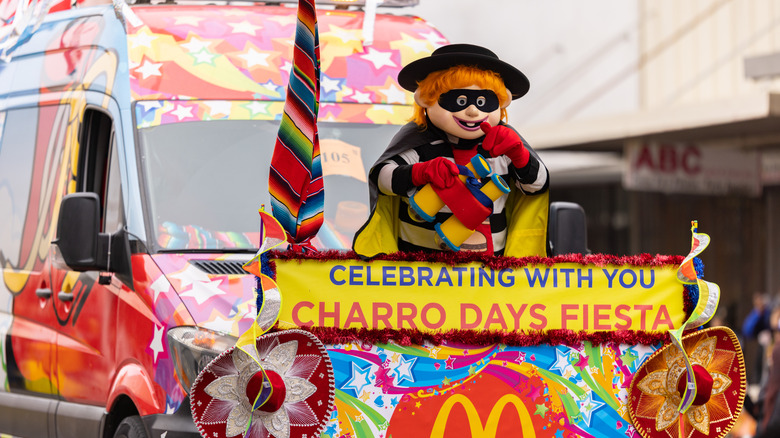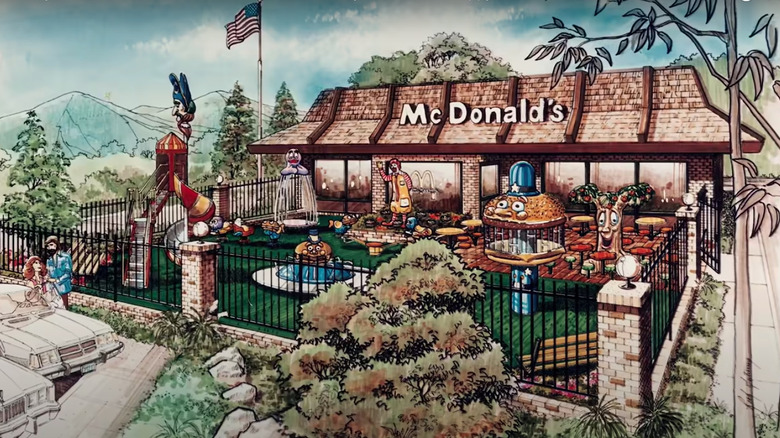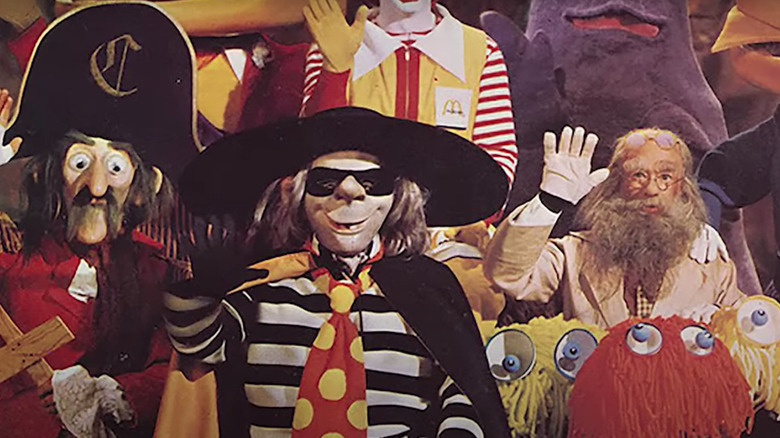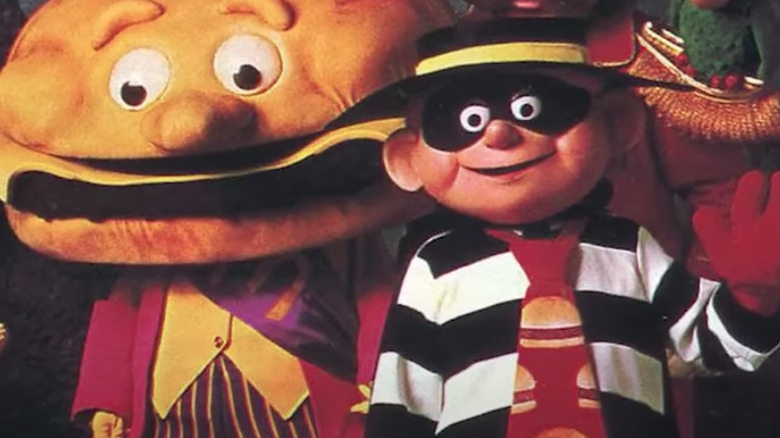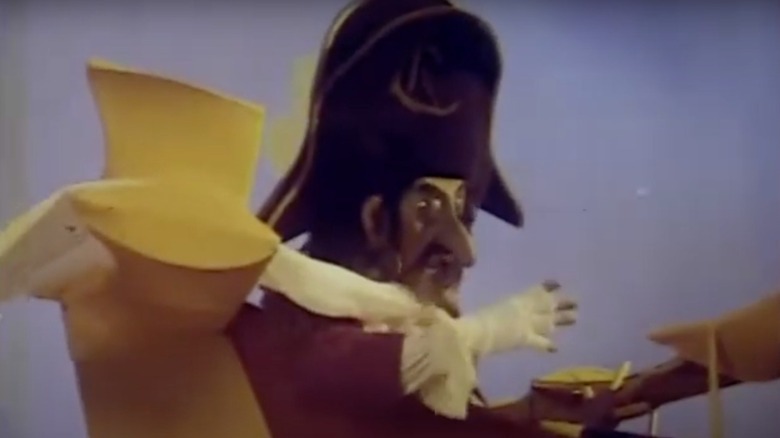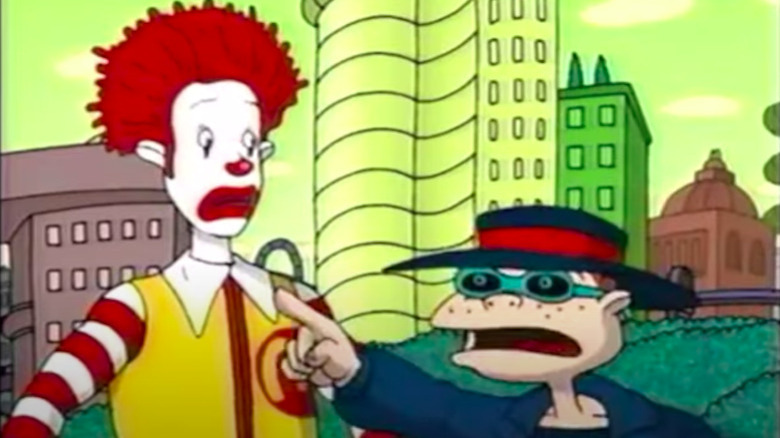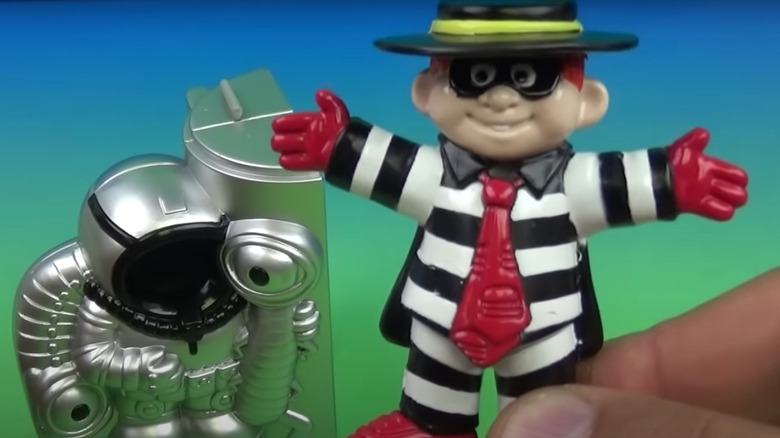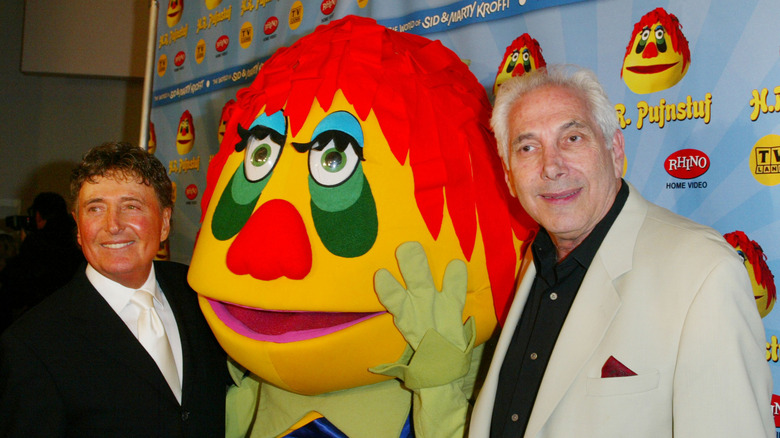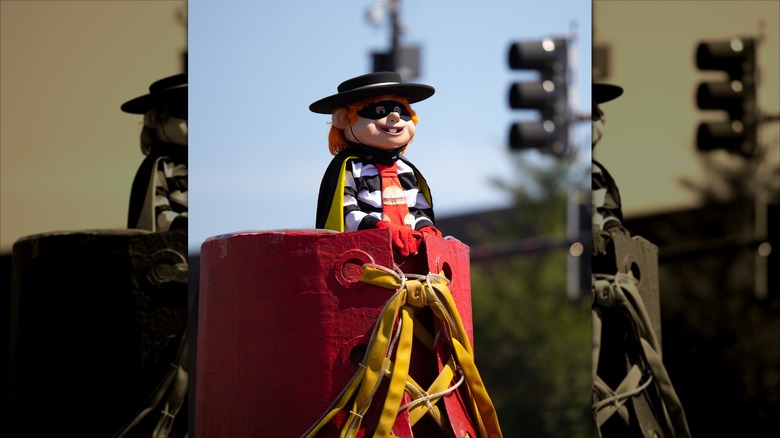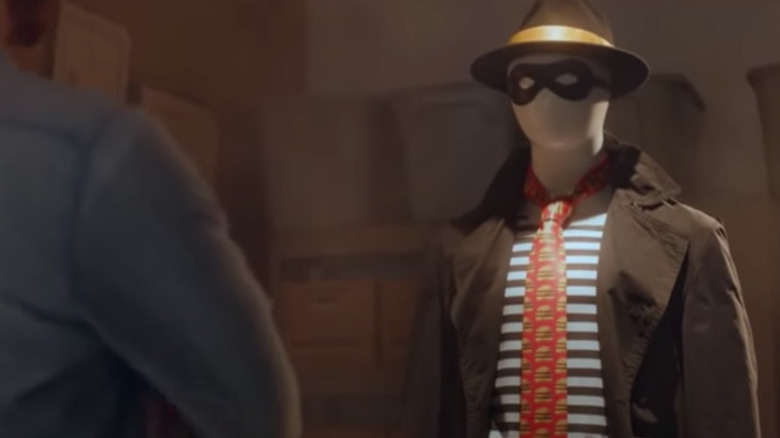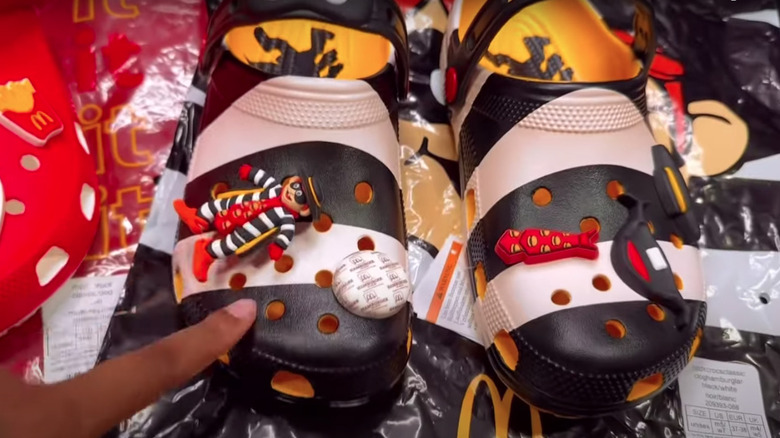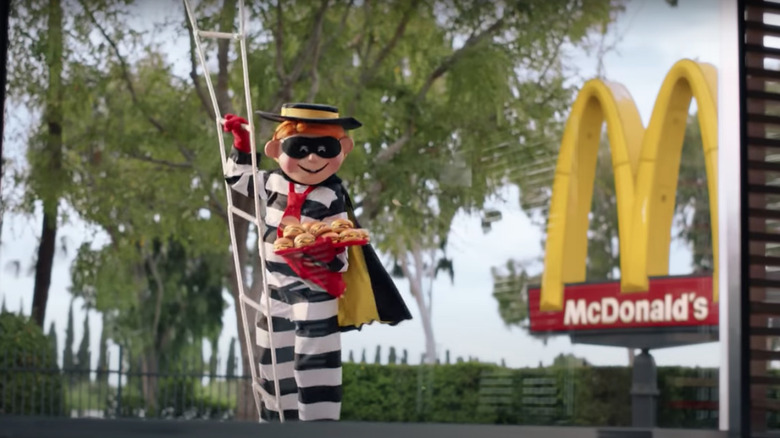The Rise And Fall Of McDonald's Hamburglar
Over the course of his long life, the McDonald's Hamburglar has received more get-out-of-jail-free cards than your average retired food company mascot. In fact, he has risen and fallen — or, at the very least, changed appearance — three, possibly four times in the 52 years since he was first unveiled as a member of the McDonaldland crew along with characters, like Ronald McDonland, Grimace, and Captain Crook. His changing faces represented a kaleidoscope of changing social and aesthetic values that has come full circle since his debut in 1971.
Like his clowny friend Ronald McDonald, the Hamburglar arose out of the McDonald's Corporation's desire to sell fast food — and lots of it — to the kids who loved the characters of, and adventures in, McDonaldland. That imaginary place featured talking trees and bobble-headed characters strolling along winding roads, all of which led back to McDonald's and plenty of hamburgers for the burger thief to hamburgle. Or at least try to hamburgle.
It's worth noting that, usually when the Hamburglar was forced to retreat back to his hamburger-filled lair of temporary oblivion, it coincided with some serious challenges, like a major lawsuit or a dietary shift that no longer embraced the hamburgers-as-wholesome-foods model. Through it all, the little imp that burger-eating audiences have come to love ultimately comes back after his long hiatuses. Here's a look at some of the most significant facts and incidents related to this beloved character, and how he rises from the ashes every time.
He was part of the McDonaldland gang
Like Zeus giving birth to Athena, the powers that be at Needham, Harper & Steers ad agency birthed the McDonald's Hamburglar out of their foreheads. The TV kids' show "H.R. Pufnstuf" had hit it big, and the creatives at the ad agency went a-knocking at the doors of Sid and Mary Krofft, the creators of the show featuring the puffy dragon and friends, to see if a collab between McDonald's and the Kroffts could be turned into marketing gold. If the collaboration became a thing, the characters — Hamburlgar included — would become a mash-up of the puffy puppet look of "H.R. Pufnstuf" and McDonald's to draw in the audiences of both brands.
The universe would go by the name McDonaldland and feature the clown, Ronald McDonald, and his friends, including his soon-to-be nemesis, the Hamburglar. Other characters in the McD's universe included Grimace, Mayor McCheese, the Fry Kids, Officer Big Mac, and Captain Crook. McDonaldland was the perfect fictional world for the campaign that McDonald's had undertaken to promote its PlayPlaces. These PlayPlaces included features like slides, ball pits, and all sorts of playground equipment you'd probably not want your kid to jump around on after filling up with a greasy hamburger and a chocolate shake. PlayPlaces would be the real-life equivalent of McDonaldland where they'd meet up with their imaginary playmates like the Hamburglar, Ronald, and the rest of the gang.
His early incarnations were kind of creepy
It might sound harsh, but creepy is the best way to describe the earliest incarnations of the McDonald's Hamburglar. The character's cute round face and affable (if not impish) nature were both noticeably absent. Instead, the Hamburglar answered originally to the Lone Jogger, and commercials featuring him saw him wearing a big hat, a mask, and a trench coat hit the airwaves. He had a very flasher-ish demeanor as he ran about, opening his trench coat to reveal the words "Lone Jogger" on his t-shirt. To add insult to injury, his greedy smile was nearly dwarfed by his pointy, somewhat trollish nose.
And the eyebrow-raising choices for the character didn't stop there. The Hamburglar's striped outfit and stringy hair are best described as prison chic. Given that the rest of the characters in the universe drew inspiration from the puffed-up puppet-like characters of "H.R. Pufnstuf," the Hamburglar definitely fell on the questionable side. Aside from this, the character didn't actually speak English, but rather various forms of gibberish, making him even stranger still and the kind of character you'd be inclined to keep at arm's length. Someone at McD's headquarters presumably came to their senses because eventually, the Lone Jogger version of the Hamburglar was replaced with more palatable alternatives.
His first rebrand in 1985 made him cuter
In 1985, the Lone Jogger became Hamilton B. Urglar, the new and cuter version of the Hamburglar. The beaky nose and white t-shirt with the name "Lone Jogger" printed on the front went by the wayside. His face got rounder, as did his nose, which became positively buttony. He looked more in line with the kind of characters you would have seen on "H.R. Pufnstuf."
In the years prior to the 1985 rebrand, another company, Chuck E. Cheese, sprang up in the fast food world — in 1977, to be exact. Mr. Cheese also underwent a cuteness factor makeover, which likely wound up inspiring Hamilton B. Urglar's move up on the cuteness scale. The other important change around this time came by way of the Hamburglar's method of communication. English, and not his famous gibberish catchphrase, "Robble, robble," conveyed his thoughts. All the changes were attempts to turn the thief into an adorable robber, making him less threatening and more inviting to kids.
Captain Crook was the Hamburglar's partner in crime
Everyone needs a partner in crime, and for the Hamburglar, that was Captain Crook. While much of the inspiration for the McDonaldland universe came from "H.R. Pufnstuf," Captain Crook takes a page literally from the written page and drew inspiration from J.M. Barrie's "Peter Pan" character, Captain Hook. However, from a looks standpoint, his appearance was closer to the 1953 movie version of Captain Hook. Given that his friend, the Hamburglar, already had dibs on stealing the burgers, the Captain's jam was stealing the Filet-O-Fish sandwich. And speaking of The Captain, he became known as just The Captain when "Crook" was stricken from his name. Aside from being the fish thief to Hamilton's burger-robbing ways, Captain Crook played interpreter for the Hamburglar during the time the burger thief spoke only in gibberish.
Before he ultimately left McDonaldland, The Captain also underwent his share of physical changes. Like his gibberish-speaking counterpart, his earlier incarnations, while not quite as creepy as the Hamburglar, still had off-putting elements. He sported a mop of stringy hair, caterpillar eyebrows, and a handlebar mustache. Later incarnations of the character made him at least more Muppet-like. The intention behind this was to make him more kid-friendly, though, in the end, he was still removed from the line-up of characters as McDonald's continued to evolve its marketing strategies.
He was a television star
We know the Hamburglar played a pivotal role in McDonald's commercials over the years, which the company dubbed "McDonaldland." But he also starred in "The Wacky Adventures of Ronald McDonald," a TV series that served as further promotion for the company. Granted, McDonald's headquarters would be unlikely to christen its "McDonaldland" straight-to-video TV series as a 40-minute commercial, but for all intents and purposes, that's what they were. For McDonald's, it was a pretty good deal all around. The company introduced the characters via its many TV commercials, enough to make kids not only want to eat the company's tasty kids' meals but also eventually beg their parents to get them copies of "The Wacky Adventures of Ronald McDonald" to watch at home.
This, conveniently for the marketing team at headquarters, forced customers to come into their favorite neighborhood McDonald's to pick up their favorite episode. Five of the six available shows were marketed like this, which pretty much guaranteed a steady stream of customers coming in to get vittles and videos in the same visit. Once again, the makeover artists were tasked with making the Hamburglar TV-ready. His look leaned toward sporty. A leather jacket — instead of the long coat he once wore — covered stylin' shorts, his striped shirt, and his tennis runners.
He played a big part in McDonald's toy branding
It might be argued that McDonald's company is just as much a toy company as it is a fast food company. With his now-round face, one-tooth grin, and fat little sneakers, the Hamburglar counts among McDonald's cuter mascots-turned-toys. And like his on-screen persona, the Hamburglar as a toy has had many iterations. On the plastic side, the Hamburglar came as part of a set of four in the McSpace set, which provided Hamilton B. Urglar with a snap-on spacesuit. In 1999, Hamburglar, Birdie, Ronald, and Grimace played on their very own playground, much like their real-life PlayPlaces counterparts at your local McD's.
But collectors aren't just limited to plastic McDonald's toys or rather plastic-only toys. McDonald's put out another series of toys by Remco. The characters themselves were constructed of plastic, but their clothes were cut from cloth and fit each character in the series as if a tailor had sewn together his duds. Aside from the Hamburglar himself, this set included Ronald, Officer Big Mac, Captain Crook, Grimace, the Professor, and Mayor McCheese. It also came with its own PlayPlace, though it was more elaborate than some other incarnations. Aside from being an action figure sold with Happy Meals at McDonald's, Hamilton is even a Funko Pop! figurine.
The character was part of an H.R. Pufnstuf lawsuit
Before there was the Hamburglar, there was H.R. Pufnstuf, a Muppet-like dragon with an oversized head who watched over a place called Living Island as its mayor. All of this may have been a footnote in kids' TV history were it not for the fact that the McDonald's corporation was sued by Sid and Marty Krofft, creators of "H.R. Pufnstuf," for copyright infringement. And the infringement in question? None other than the "McDonaldland" series, which looked suspiciously like Living Island and all of the characters therein, including a Muppet-like mayor with an oversized head.
This wasn't a Happy Meal accident. Prior to production of the McDonald's series, the ad agency for McDonald's, Needham, Harper & Steers, looked up "H.R. Pufnstuf" creators, Sid and Marty Krofft, to ask them about basing a McDonald's-themed show. The Kroffts agreed but were later told that plans for the show had been scrapped. They hadn't been. The series went forward with the Kroffts' ideas, but no Kroffts.
In all of this, Hamburglar remained one of the few characters who didn't look as much like the Krofft puppets. That said, when the case finally met its resolution, the courts had decided that the overall look of the series, and not one specific character, matched the "H.R. Pufnstuf" world too much to be just a coincidence, allowing the Kroffts to win their copyright suit six years after filing it.
The Hamburglar went down for the count in the early 2000s
After being a steady part of the McDonaldland gang for years, including up through the 1990s, the Hamburglar more or less disappeared from commercials in the early 2000s. His disappearance was tied, in large part, to the disappearance of Ronald McDonald himself. The great Clown Prince of McDonaldland fell victim to changing public sentiment. The hamburger-eating public was getting older and at the same time, more diverse. In order to stay relevant with the burger-buying public, McDonald's shifted its advertising away from McDonaldland and the gang and more toward adults.
In keeping with this, McDonald's introduced its longest-running ad campaign, the "I'm lovin' it" campaign which it launched in 2003. That same year, the McDonaldland series was shelved. New campaigns emphasized personal autonomy. This played out in a switch to "I'm lovin' it" from ad campaigns, like "You deserve a break today" and McDonaldland. While child-like youthfulness may have played a role in its new marketing attempts, childish attachments didn't. McDonald's no longer needed a made-for-TV series featuring characters that were knock-offs of a '70s show. McDonald's also faced backlash for using kid-friendly characters, like the Hamburglar, to promote unhealthy eating habits among kids. Anything that didn't fit with McDonald's new branding philosophy and a stronger emphasis on a healthier way of living had to go, including Hamilton B. Urglar, better known as the Hamburglar.
In 2015, he reappeared as a flesh-and-blood man
When the character rose once again from the ashes in 2015, like the proverbial phoenix bird, he looked decidedly different — more adult, less cutesy trickster, and certainly not like the stringy-haired flasher-ish man of the early commercials. But that doesn't mean the new-and-improved, more grown-up, more human version of the Hamburglar didn't raise eyebrows. He sported a five-o'clock shadow, auburn hair, red gloves, and a very impish grin, which earned him the kind of fans that earlier incarnations of the Hamburglar never had. In terms of the commercials themselves, they lost their layer of baby fat, in a manner of speaking. Slick production design gave the new commercials the look of a hard-boiled detective novel, and over-the-shoulder shots of the Hamburglar facing his costume fit in better with the graphic-novels-come-to-life in the Christopher Nolan version of "Batman" than they would the former McDonaldland universe.
The grown-up Hamburglar also had a more adult job to do. In the old days of the character, promoting kid-sized burgers and the delights of McDonaldland were the domain of the Hamburglar. The 2015 version of Hamilton pushed the Sirloin Third-Pound burger. The goal was to make the burger giant seem like a more "progressive" burger company, per Fast Company. The grown-up Hamburglar played a big role in that evolution, at least for the duration of that ad campaign.
The Hamburglar has a social media presence
Like Hamburger Helper's Lefty, another iconic food mascot, the McDonald's Hamburglar has his own social media accounts. The Hamburglar's admirers not only follow his social accounts but sometimes parody him on social media, possibly to siphon off a bit of the love intended for the Hamburglar and onto themselves.
But parody accounts aside, the Hamburglar did get a chance to play a bit on X, formerly known as Twitter, and on Snapchat, when McDonald's released its Sirloin Third-Pound burgers in 2015. The naughty new version of the character encouraged his followers to tweet #RobbleRobble to help pull his pursuers off his trail as he goes in search of his beloved burgers. That social media campaign represented an identity makeover designed to attract more millennial followers.
However, the funniest of all of Hamilton B. Urglar's accounts may be his LinkedIn account. Its meta description reads, "Corporate Espionage (Retired)." The once-thief was and will remain a hamburglar in perpetuity by the looks of it.
McDonald's and Crocs are revitalizing the character
McDonald's never has been shy about partnering with other brands to sell goods. Most notable, of course, are the Happy Meals featuring movie characters, but the cross-branding doesn't end there. In 2023, the burger giant made a deal with Crocs footwear to create a series of Crocs shoes based on some of the McDonaldland characters. The big purple one, Grimace, and the striped bandit himself, Hamilton B. Urglar, provide the inspiration for these colorful Crocs. McDonaldland friend, Birdie, will get her own shoe, too.
The four different styles of shoes include elements that give their inspiration away from the first glance. The Grimace sandals sport a deep purple shade, while the other shoes — which are Crocs in style — feature a deep red as a nod to McDonald's red and yellow for Birdie. Naturally, the Hamburglar gets a design that, arguably, might be the most fun: stripes, in honor of the striped jailbird outfit he normally wears. Acquiring the shoes will set fans back by $70 to $75. It'll cost them another $20 or so if they want to buy the matching socks.
McDonald's new menu gets an old face
In 2023 and 2024, McDonald's burgers will be "Hotter. Juicier. Tastier," and an earlier incarnation of Hamilton B. Urglar will be on hand to get his hands on these new-and-improved burgers. The new menu rollout features burgers with a softer bun, caramelized onions, more sauce, and the meltiest cheese you'll find this side of your grandma's Sunday dinner mac and cheese recipe. Gone is 2015's edgier, more grown-up human model of the Hamburglar. He's been replaced by the cartoony cutie that ousted the original creepy-old-man burger thief from the original 1970s commercials.
Burgers that are getting the star treatment in this new campaign include the basic hamburger and cheeseburger, the double cheeseburger, the Big Mac, and the McDouble burger. In addition to an international rollout in countries, like Belgium, Australia, and Canada, many West Coast and Inland Northwest cities, like Boise, Salt Lake, Phoenix, Seattle, and San Francisco, will take part in the early rollout efforts. But if you're not in one of these places, never fear. The Hamburglar will be at a McDonald's near you to steal your burgers no later than 2024.
